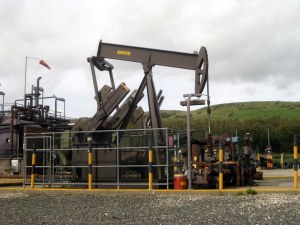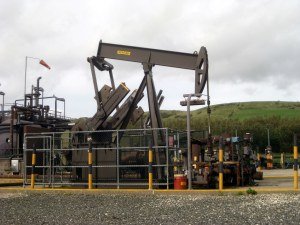Sighted on the edge of the Jurassic cliffs in Dorset, the Kimmeridge Well pumps away as it has done for nearly 60 years.
Who would have guessed that it has been quietly venting methane in quantities that are hard to believe.
An industry insider gave the heads-up and after verification with the Environment Agency, it also became clear that not only was the well cold venting methane, it was doing so by design. Unlike in the United States and Australia, where methane has bee shown to leak from poorly manage fracking wells, the Kimmeridge well is not leaking, it is simply not designed to capture or combust and flare off the gas that accompanies the oil upon extraction!
It isn’t a recent problem that is an unfortunate blip, the well has been venting methane since 1961! It turns out that the Kimmeridge well is operating under an old style permit that has lower emissions standards. What is more, there are tens of other wells out there also regulated under the same type of permits.

By Huligan0 [CC BY-SA 3.0 or GFDL], from Wikimedia Commons
Some facts according to the EA:
“the “nodding donkey” site at Kimmeridge has a permitted release point for methane”
“the operator has tried unsuccessfully to abate this release”
“Last year the site, operated by Perenco UK LTD, produced 3,179 tonnes of crude oil and it is estimated that this could lead to the release of up to 284 tonnes of methane.”
So, what does this mean in ‘real terms’? How damaging is this? To get a perspective of the total methane that the Kimmeridge well has vented, I will set out some calculations.
Assumptions
- Production of 3 m barrels of oil up to 2003, ignoring additional production over the past 15 years. (Gluyas et al. 2003)
- Gas captured during trial periods of different production processes has not been assessed.
- The oil is accompanied by methane and the relative proportion of each can be measured and expressed as a ratio. The EA have given figures for 20017 which suggest a ratio of 0.089336 parts gas per unit of oil. The OGA figures give a ratio of 0.182083 ‘associated gas’ per unit of oil for the same period. It is unclear what the ratios are so different and whether this is due to other gases included in the OGA figures. My calculations will use the more cautious, EA ratio.
- The oil to associated gas ratio has been the same over the life of the well as per the 2017 EA figures
- The green house gas impacts upon climate change, radiative forcing, vary for different gasses. They can be cross compared or totalled using a common baseline of Carbon Dioxide equivalent (CO2e). Methane is a stronger greenhouse gas than CO2 but the relative strength declines over time. I will use a mid-point figure of 30x for conversion.
Total oil production 3m barrels
This equates to 420,000 tonnes of oil
Total Gas vented to the atmosphere by the Kimmeridge well is therefore approximately:
420,000 x 0.089336 (EA ratio for 2017) 37,521 tonnes methane
Expressed as Carbon Dioxide equivalent:
37,521 x 30 = 1,125,637 tonnes CO2e
To give some sense of perspective, estimates of the carbon footprint for a UK citizen are about 10 tonnes per year. Based on these figures, the Kimmeridge well has produced at least as much CO2e by the venting of methane to match the pollution from 112,500 people’s carbon emissions for an entire year. The population of Poole, the closest large town to the well, is about 150,000 people.
The regulatory system appears to be permitting gross levels of pollution that are at odds with legally binding climate change commitments including the 2008 Climate Change Act.
It is clear the mitigation options have been investigated but the most obvious and simplest approach in my opinion would be to close any well that is not designed to avoid methane emissions.
This one small well exposes wider concerns. A regulatory system that has approved massive levels of pollution. An industry that is apparently prepared to operate to the minimum standards that regulations impose, however low.
Obviously, it also raises further questions about the operator – Perenco’s and their other sites including Wytch Farm. As it stands, Perenco has declined to comment.
This also raises serious questions about the “Gold Standard” regulatory system that is being promoted as the impenetrable firewall to defend us and our environmental from any additional dangers posed by fracking.
At a time when the government is seeking unprecedented levels of trust and centralisation regarding the process to approve new wells, this example demonstrates that local people with concerns about local installations are important in the planning process. Sometimes they are the ones that ask the overlooked questions and hold institutions to account.
- Gluyas, J. G., Evans, I. J. and Richards, D., 2003. The Kimmeridge Bay Oilfield, Dorset, UK Onshore [Periodical]. GEOLOGICAL SOCIETY, LONDON. Available from: https://search.ebscohost.com/login.aspx?direct=true&db=edsbl&AN=RN147011281&site=eds-live&scope=site [Accessed 10th September 2018].
How Can You Help?
Read the letter, get familiar with the facts
Spread The Word.
Tweet #NoMethaneVenting
Stay Tuned!







